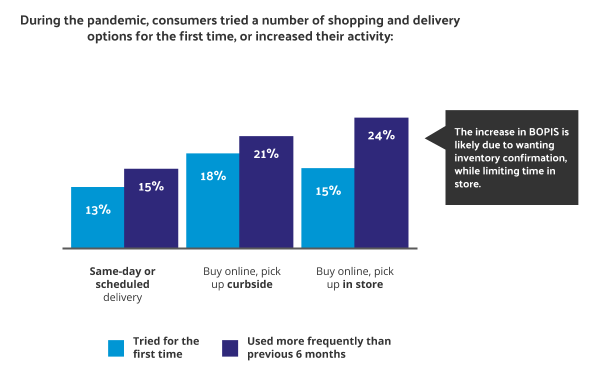
AI-powered delivery date estimates to boost conversion
Give shoppers peace of mind and protect and grow your bottom line
Personalized tracking experiences to build brand loyalty
Returns and exchanges management to mitigate fraud and reward best customers
Proactive communication to drive customer lifetime value
Delivery claim management to tackle fraud and build trust
How Communication Combats "Shipageddon"

In a year of disappointment and heartbreak, it’s sadly not a surprise to see more of the same this holiday season. Many communities are heading into a second wave of lockdown measures to help combat a resurgence of COVID cases, plus fatigue is setting in after nearly a year of sacrifice and high tension.
We all hoped to have some semblance of a normal holiday season, replete with gifts, especially in lieu of being able to travel or gather the way we would normally celebrate...alas, a massive carrier capacity crunch due to the shift towards ecommerce is attempting to foil these efforts.
The good news is that vaccines are just starting to be available and an end is in sight; the bad news is that in the short term, logistics to deploy the vaccine may strain shipping capacity even further.
Early spikes in ecommerce activity this Spring & Summer forced retail & the supply chain to adapt despite incredible disruption, and it seemed as if we’d all be better prepared for the holiday given this dry run.
On the Narvar platform we saw fulfillment times at retailers’ warehouses (the processing, pick & pack time between when an order is placed and when the package is handed off to a carrier) double, from an average of 1.9 days to over 4, though that improved in the Fall as everyone found their footing again. Many retailers pulled holiday promotions earlier in the season in an attempt to spread order volumes across a longer period and avoid last minute spikes.
Early spikes in ecommerce activity this Spring & Summer forced retail & the supply chain to adapt despite incredible disruption, and it seemed as if we’d all be better prepared for the holiday given this dry run.
Yet despite all these preparations, there is still only so much capacity available which is causing considerable delays and even throttling of package pickups in an attempt to maintain a healthy supply chain, and weary customers are ready to snap if they haven’t already. Besides scrambling to find alternative carriers or delivery services (often at a higher cost) to help alleviate these bottlenecks, what can retailers do to mitigate the effects of “shipageddon" and still have a happy holiday?
Communicate, communicate, communicate.
There is no such thing as overcommunication when it comes to package delivery status — consumers have told us so time and again. In our most recent consumer study which covered the pandemic timeframe, 36% of customers surveyed said they’d experienced extreme shipping delays, but 19% of those reported receiving good communication along the way which helped temper expectations and bolster sentiment.
Even if it’s bad news about a delay, 98% of consumers expect the retailer to proactively keep them informed, and feel better about a company who does so — a classic example of service recovery (the principle that if you fix a problem, customers often feel even better about your company than if nothing had gone wrong in the first place).
Narvar retailers who ramped up messaging, including adding “fulfillment delay” emails to help cover those warehouse disruptions, saw an average 70% open rate by appreciative consumers.
36% of customers surveyed said they’d experienced extreme shipping delays, but 19% of those reported receiving good communication along the way.
Most retailers already have banners across their websites clearly warning consumers of delays, but it’s important to reiterate at every step in the journey including in the cart and with a broadcast message on tracking pages.
Being able to provide an accurate estimated delivery date as early in the shopping experience as possible can also help set expectations up front. Narvar provides gift tracking, so givers can share the anticipation with the recipient without revealing what’s inside, and keep both of them apprised of when to expect the gift to land on the doorstep.
(Narvar customers: if you need assistance implementing or updating any of the features mentioned in this article, please contact your CSM or email us here.)
Leverage stores or physical retail holistically
For retailers who have a physical presence, it may be challenging to figure out how to drive consumers to stores without sounding tone-deaf given safety restrictions.
But this pandemic has quickly taught consumers to adopt alternative methods of thinking about the store, including Buy Online Pickup in Store (BOPIS), curbside pickup, and alternative returns drop-off locations.
Our recent research found that about a quarter of consumers used BOPIS and curbside pickup more frequently than prior to the pandemic, with another 15-20% trying these services for the first time.

Consumers are seeking convenience & predictability, which is what makes this combination of online shopping and physical pickup appealing to them—they're guaranteed inventory availability, but take the wait for delivery and potential delays out of the equation. These options also preserve store capacity (both to accommodate shoppers and staffing associates to help them) for discovery and evaluation activity that may be more difficult to handle online.
Bear in mind you may also have an advantage with local audiences: 56% of consumers tried new retailers during the pandemic, many of whom were just experimenting and or wanted to support local business.
Stagger or reduce returns - and make them more efficient
It’s common knowledge that return rates for online purchases are 2-3 times higher than in-store purchases, especially when it comes to categories like apparel, footwear, and home goods where fit, feel, and style are critical.
In the same way many retailers tried to anticipate shipping limitations and spread out promotions in an attempt to flatten the curve of holiday shopping spikes, methods to stagger returns can also help alleviate some of the volume going through the carrier system.
Extend return windows and amend policies to spread out when returns come back. By using an online returns portal like Narvar’s, you not only get the visibility of what is coming back and why, and can choose to provide a refund or ship an exchange item earlier in the process (perhaps just for VIPs) to maintain a great customer experience, but can also manage where returns are directed and at what speed to make it most efficient and economical for your business.
By using an online returns portal, you can also manage where returns are directed and at what speed to make it most efficient and economical for your business.
You can also use insights from aggregated returns reasons data to help prevent some returns in the first place by improving the details on the product detail page in near-real-time, especially sizing/fit advice or better quality photos to details or context. [Read Yeti’s success story to learn how they creatively demonstrate cooler sizes to help customers make better purchase decisions.]
Practice and encourage patience
In this age of technology, we’ve come to expect everything immediately, at our fingertips, on tap. Even as the pandemic has forced us to rely on tech even more than before, in many ways it’s led us to go back to basics as we crave human connection and comforting, non-screen-based activities. The rise in old-school hobbies like bread-making and home cooking, crafting, DIY, and board games is testament to that return to a simpler lifestyle.
Beyond communication and these other measures outlined to manage expectations, how can we reset the conversation and encourage patience, especially when things are out of our control?
Yet many of these same folks (including all of us, with our consumer hats on) still expect our packages to come like clockwork, despite logically knowing that everything is disrupted, including delivery services and other businesses.
We’ve all heard from our share of unreasonable consumers who seem to feel that the proactive messaging retailers have blanketed their sites with don’t apply to them, and a week-long deviation from normal delivery times is unacceptable...and they take to Twitter to share those feelings.
To a certain extent we as an industry are to blame for this expectation of speed regardless of anything else going on in the world.
Beyond communication and these other measures outlined to manage expectations, how can we reset the conversation and encourage patience, especially when things are out of our control? Looking back at some of creative ways retail responded early in the pandemic during that initial moment of uncertainty, it seems that content and community seem to be good ways to engage customers on a more personal level.
Whether it’s jumping on the livestream-shopping trend that Alibaba and China mastered and is catching fire in the Western world, or providing access to your in-house experts via a more intimate remote conversation, personal shopping services, tips and how-tos for styling, DIY or crafting tutorials, virtual happy hours and tastings, or simple ways to improve how we share time with family & friends in our households or remotely—all of this valuable content and interactivity can humanize your brand, and soften the blow of unavoidably delayed shipments.
As we eventually put this year behind us, tackling these unusual challenges will have armed us with new strategies and reinforced proven ones to make us stronger, more nimble, and hopefully more patient.
























